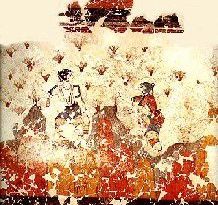Cycladic civilization (3000 BC-2000 BC.)
Cycladic civilization (also known as Cycladic culture or The Cycladic period) is an Early Bronze Age culture of the Cyclades in the Aegean Sea, spanning the period from approximately 3000 BC-2000 BC.
The significant Late Neolithic and Early Bronze Age Cycladic culture is best known for its schematic flat female idols carved out of the islands’ pure white marble centuries before the great Middle Bronze Age (“Minoan”) culture arose in Crete, to the south. These figures have been looted from burials to satisfy the Cycladic antiquities market since the early 20th century.
A distinctive Neolithic culture amalgamating Anatolian and mainland Greek elements arose in the western Aegean before 4000 BC, based on emmer wheat and wild-type barley, sheep and goats, pigs, and tuna that were apparently speared from small boats.Excavated sites include Saliagos and Kephala (on Keos), which showed signs of copper-working.
Each of the small Cycladic islands could support no more than a few thousand people, though Late Cycladic boat models show that fifty oarsmen could be assembled from the scattered communities. When the highly organized palace-culture of Crete arose, the islands faded into insignificance, with the exception of Delos, which retained its archaic reputation as a sanctuary through the period of Classical Greek civilization.
The chronology of Cycladic civilization is divied into three major sequences: Early, Middle and Late Cycladic. The early period, beginning ca. 3000 BC segued into the archaeologically murkier Middle Cycladic ca. 2500 BC. By the end of the Late Cycladic sequence (ca. 2000 BC) there was essential convergence between Cycladic and Minoan civilization.
Cyclades
Lat: 37.105574634377874
Long: 25.301513671875

